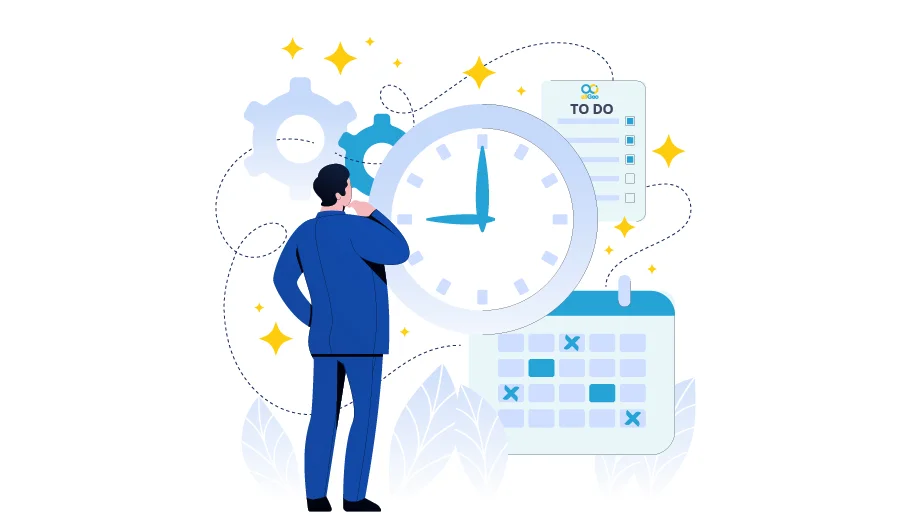Efficient management of time commitment plays a critical role in employee satisfaction, thereby optimizing productivity and ensuring smooth operations for businesses. Proper attendance management therefore become a must for field services companies.
Most businesses face challenges when it comes to time and attendance management, such as:
- Errors in attendance records
- Buddy punching
- Manual cross-checking of payment errors
- Data not compiled in one place
In the ‘fourth industrial revolution’, businesses ahead of the curve have bid goodbye to shuffling papers for attendance logs or manually checking payroll errors. Manual attendance tracking methods are prone to errors, time theft, and administrative burdens. In fact, while using manual methods, 80% of employee timesheets have to be corrected. Embracing automation through an automated attendance management system can significantly streamline this process.
Today, there are several software solutions designed to manage employee time and attendance per business needs. Even small and mid-sized organizations have adopted solutions to manage attendance. In the case of field services, it becomes even more crucial to switch to automated attendance trackers due to the nature of the work they undertake in the field.
For instance, a construction business manager has many contractors, sub-contractors, and employees working across multiple job sites. To avoid underpayment or overpayment, he/she must have properly compiled attendance records in one place. Automated time and attendance apps do just that and moreover, they can be integrated with payroll software too.
It is likely that your business is also a victim of time theft as a report reveals that 75% of all US businesses are affected by it. Annually, it can cost employers a whopping $11 billion. A Workplus report of 2020 states that because of not tracking attendance and time, employers end up overpaying 200 billable hours annually.
Time-tracking apps alone give insights only into the hours taken by employees to finish their tasks. When coupled with an employee attendance tracker, you can get a complete overview of every employee’s working hours, monthly/weekly reports, etc.
In this blog, we will walk you through some of the best practices you can adopt for attendance management. But first, let’s understand the benefits of having an automated attendance management system in place.
Benefits of Attendance Management System
- Insights: If you need a record of a specific employee or group’s attendance, they will always be available to you in just a few clicks. Detailed records of work hours, absenteeism, overtime, and summary records are readily accessible to managers from any device. It allows them to further edit, adjust or compensate leaves, etc. with attendance data.
- Streamline workflow: Various HR tasks like payroll, performance assessment, etc. can be streamlined with the help of an integrated attendance management solution. It automatically sends notifications in cases of leaves or other requests, thereby minimizing the need to physically contact an employee or manager. Manual assigning of tasks or tracking shifts can be done with a few clicks.
- Enhanced productivity: In any organization, low productivity becomes the biggest cause of reduced profitability. An average of 5 hours per day of manual entry results in a loss of 150 hours worth of work every month. With an automated system, manual tasks like updating work hours can be cut down to only a few minutes.
- Controlling costs: Attendance and cost may seem unrelated on the surface. But, problems like absenteeism, buddy punching, time theft, etc. tend to decrease the return on employees. Through time and attendance automation, it becomes impossible to tamper with the saved data or buddy punch. With fewer payroll errors, you will also save costs on overpayment or underpayment.
- Mobile accessibility: In the field services industry, since employees may not always be present in one single place, cloud-based software allows remote access to data. Using the mobile application and their unique ID, employees can view their attendance records, check their schedules, etc.
With the monumental advantages of setting up an integrated employee attendance tracker, you should make the switch from manual to automated at the earliest. At the same time, to make the maximum of your investment into software, there are a few best practices to be followed. You will notice a measurable increment in your productivity and enhanced work culture by embracing the four best practices mentioned below for attendance management.
Best Practices: Attendance Management
1. Conduct regular audits: If conducted at regular intervals, audits of attendance data are crucial to identify and address any irregularities or discrepancies. Attendance trackers provide comprehensive audit trails that enable you to track changes, review historical data, and identify potential issues.
Regularly review attendance data and generate reports to monitor attendance trends, identify patterns, and address any recurring issues. Analyzing the data can help you make informed decisions and improve overall attendance management. Attendance data can help you optimize your field service operations. By identifying trends such as high-demand periods or recurring attendance issues, you can allocate resources more effectively, optimize work schedules, and improve productivity. Further, the analysis of attendance data enables businesses to make informed decisions regarding attendance policies, scheduling, and resource allocation.For example, if you notice a consistent pattern of late arrivals in a specific team or location, you can explore the reasons behind it and implement targeted solutions, such as adjusting schedules or providing additional training.
2. Train your employees: Provide comprehensive training to your field service employees on how to use the attendance management system effectively. This includes understanding how to log attendance, report issues, and clearly understand the attendance policy to avoid misunderstandings.
You can also tailor the training to different roles within your field service team. For example, supervisors or managers may require additional training on how to review and approve attendance records, generate reports, or handle exceptions. Customize the training content to address the specific needs and responsibilities of each role within the attendance management process.
Having an environment of open communication improves a business’ functioning. Ask for regular feedback and suggestions related to the attendance management system from employees. Addressing their issues promptly guarantees employees’ trust in using the system.
3. Maintain employee privacy: Having a time and attendance tracker requires access and storage of large amounts of employee data– from personal information to real-time location. Make sure that strict guidelines about the data collected via the attendance tracker are followed. Employees should also be made aware that there are privacy regulations and safeguards in place to protect their data from unauthorized use.
Familiarize everyone with relevant privacy regulations and laws governing the collection and handling of employee data. Ensure that your attendance management system complies with these regulations and any other applicable local or industry-specific privacy requirements.
Access to employee attendance data must be restricted to authorized personnel. User roles and permissions should be laid out within the system. A regular audit of user access to prevent unauthorized access or misuse of employee data will prevent any potential security breaches.
4. Integrate with third-party systems: Businesses usually have many systems they use for various functions including HR, CRM, ERP, and Payroll software. It is critical that your time and attendance solution is able to receive and deliver data seamlessly to all these systems. allGeo is specifically designed as a versatile platform to integrate seamlessly with the customers existing workflow.
For example, allGeo can enable the transfer of customer information from a CRM like Salesforce to the allGeo platform. Businesses can then utilize the allGeo mobile app to assign tasks to their field staff for each client or customer. As the assigned tasks are completed and data is collected in the field, all the customer visit logs and field activity information can be synced back to Salesforce. The time data can be sent directly to an ADP payroll system along with job codes for payroll processing.
Conclusion
In a quest for revenue and profits, businesses tend to look for opportunities outwards. However, simple changes in the ways of functioning within the organization can lead to many enhancements in field service businesses.
Since employees are the most significant asset, increasing their productivity would lead to visible improvements in your organization. Implementing an automated attendance sheet is the best investment your company can make right now. Following the simple best practices will give you better results in a short time.



